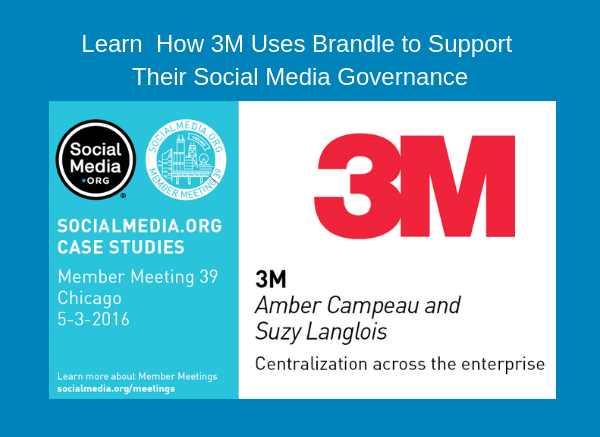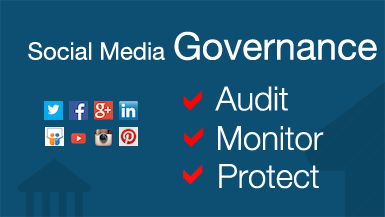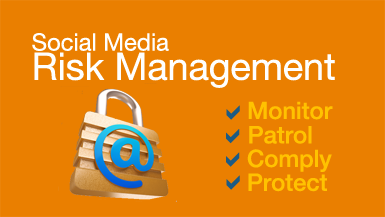Last week I began a series on Social Media Governance with the first post titled 3 Keys to Managing Your Social Footprint. In that post I stressed the distinction between social presence governance and social content governance. For a decade people have focused their governance concerns on what can and cannot be said within the content stream of social networks, placing guidelines in a corporate social media policy. This is social content governance.
With the proliferation of social media and the expansion of social business, companies have hundreds and even thousands of social points of presence that represent their company, products, identities and campaigns. These points of presence (POPs) should be considered critical corporate assets that need to be maintained, governed, and protected. Because it is so easy to create a POP, it is also critical to discover unauthorized POPs (both friend and foe) in order to protect your trademarks and ensure customers are seeing an authentic representation of your company. This is social presence governance.
The three keys to a social presence governance plan are to audit, monitor and protect your company, brands and IP (intellectual property). If your business is within a regulated industry, you need to escalate your governance strategy to include third-party POPs (such as employees, partners, and distributors) that associate themselves with your brand. This post details an audit process that will help you minimize corporate risks to reputation and IP stemming from social media POPs, and ensure customers receive a consistent brand experience.
SOCIAL MEDIA AUDIT
A social media presence audit is basically the process of reviewing what exists, deciding what risks to watch for, and then scouring the web to discover everything that remotely looks like your brand. The basic elements of a point of presence (POP) includes the URL, identifying name, avatar/brand image, and the profile information (descriptions and information). The audit plan should also have a triage strategy for how you will process properties you find, especially those that are infringing on your IP, or don't meet brand or compliance standards.
Conducting a brand audit is no small task. In fact, it can be overwhelming if you are protecting a very large brand and IP portfolio, or if you have a "noisy" brand. A "noisy" brand is an identity that contains a common word, such as "Gap", and you will find thousands of POPs that may or may not be related to your brand. You will need a lot of patience to manage a noisy brand or have an experienced digital organization such as W2O Group or Resource or a larger business consulting firm such as PwC conduct your audit.
We created Brandle to make this process easy and continual, but you can certainly conduct an audit manually. If you are handling the process on your own, you must first conduct a major review. Once review is complete you are ready to discover, triage, and inventory based on your audit plan. Here's how you make that happen for a thorough brand audit.
REVIEW
Trademark and IP Review the corporate intellectual property with your legal counsel. This includes all trademarks, product names, trademarked campaigns and taglines, as well as other IP that counsel believes should be protected. Your counsel will be very clear about what they believe the risks are in social media and on the web. Be sure to understand your trademarks and their classifications so you can appropriately inventory and flag properties you find. You may find properties using a trademarked name, but if they are in a different classification, then you know that they can be ignored (as your company has no claim over a trademark in a different classification).
Social Media Policy Review the most recent policy and determine which elements should be considered when you find a property related to your brand(s). Pay special attention to what is required in employee profile information. For example, you may encourage employees to use their own Twitter accounts to weave brand stories to their followers, but you may require them to state, "Although I work for awesome company X, my tweets are my own". Whatever is in your policy regarding presence attributes, you need to include in your audit.
Compliance & Regulatory Guidelines If you are in a regulated industry (Financial, Healthcare, Alcohol and Tobacco, etc.) you are aware of the importance of managing risks when communicating with the public. Make sure you are very clear on the new guidelines — 2013 was a watershed year for regulatory guidelines and 2014 promises to keep the pace. Be ready to review whether your POPs are in compliance when you begin the web discovery process. Review the guidelines with your legal counsel and discuss the actions that will need to take place depending on what you find.
It is important to note that most of the regulatory bodies are starting to indicate that a blanket prohibition of social media is no longer sufficient compliance management. Many businesses are required to be watching for compliance issues around their brand whether they are social or not. The regulatory bodies are performing spot checks (such as the FINRA spot check program) to make examples of companies; make sure you and your company are not an example!
Employee Social Access Know who has control over the POPs within your company and ensure there is a workflow in place should that person leave the company (or goes on vacation). Now is also a good time to ensure that the company (and not a consultant, agency or employee under their personal email) has actual control of the accounts! These are corporate assets and there should be a clear line of ownership to corporate email accounts.
Brand Standards Just as in printed pieces, your brand standards should be applied to your social properties. This includes logo use, avatar imagery, and messaging for descriptions (short and long). You will also be looking for POPs that incorrectly use your brand standards and you will need a plan on how to address them be they an advocate, employee, or partner. Of course, involve legal should a POP appear to be infringing on your IP. Your Legal counsel team meeting should include a discussion on how to escalate and process the items you find that are concerning.
Social Business Strategy & Goals Review the corporate social business strategy with all stakeholders in the company. You are about to embark on a wide search so know the corporate strategy and goals for each department and have a workflow that includes a department point person in the audit process.
If third-parties (such as certified partners or authorized resellers) are an important part of your business, include a review of the third-party contracts to understand the parameters of the marketing clause. During the discovery process you will want to track third-parties that need assistance complying with the contract in their marketing efforts. There should be a team member responsible for these partners on the social media audit task force.
This is also a great opportunity to discuss future social goals. For example, let's say your company has a 2014 goal to get 60% of your customer-facing employees using social media. If this is the case, you will want a clear strategy on how you will find employee POPs in the discovery phase, how you will roll out and train employees as social brand advocates, and how you will collect and inventory employee POPs on an ongoing basis. Read about the power of employees as brand advocates in Ekaterina Walter's Forbes post for why this is such a strategic idea!
DISCOVER
Now you are ready and armed to begin searching the web for all social sites using your brand identities, campaigns, and trademark information from legal. If you are responsible for all digital properties, you will want to include domains as well as social sites. If you are responsible for social media only and not other digital properties, then you will only review social media networks. This is where patience and diligence is necessary. There is no secret to looking at every social network for all of the trademark elements used in accounts, but the more specific and thorough you are at this time, the better your brand and risk protection is in the future! Remember, you are looking for the basic elements of a POP which includes the URL, identifying name, and the profile information (descriptions and information).
To be thorough, you need to search for and be prepared to process:
1. Corporate Properties managed by the company or agent of the company.
2. Third-party Properties.
- Employee VIPs such as CEO and other executives that have a following
- Employees that claim a relationship to the brand
- Licensed representatives (such as independent agents)
- Advocates claiming a relationship to the brand
- Others (such as partners, retailers, etc)
3. Infringing Properties (infringing on IP, counterfeiters, phishers, etc).
TRIAGE
Once you have found everything of interest, you now need to determine how to handle them. You are most likely using a spreadsheet to track this data if you are managing this process manually. This is where the review process comes into play and how you may use the wider social team in other departments to help. You must determine:
1. Is this POP important to track as corporate, third-party or infringing?
2. Does this POP need attention such as new compliance language or brand standard update?
3. Is this POP infringing on IP or a counterfeit site?
For anything that is not worth placing in your inventory to track, you may want to place in a list of ignored POPs. The benefit of this is to be able to quickly assess and ignore these accounts when you find them in the next audit.
For anything infringing, you need to send to legal so they can begin the process of correcting the infringement or to issue cease and desist notifications. You will want to monitor these to ensure they are following through on the legal requirement.
For the items you want to keep track of, you need a system of assigning them a category. You may want to track them by department, then by type (such as placing advocates for different product lines within their product line team). You will also need an implementation plan for making the changes required to meet brand and compliance standards. Implementation needs to include a workflow with other stakeholders.
The audit process uncovers a great deal of knowledge about how your brands are being represented digitally and you will begin to see a clear path on what needs to be changed in your social business practices. Ensure you have a process for collecting new ideas, a prioritization system which includes other stakeholders, and the rationale for implementation.
INVENTORY
The inventory is simply the system you choose to implement tracking the POPs found through discovery and the triage process. Most companies use a spreadsheet and have assigned roles for accessing and changing the information. The most critical aspect of the inventory is to recognize that a spreadsheet is a static thing, so as soon as you complete the process, it is outdated. Also, research has shown that almost 90% of all spreadsheets have errors, so you need to be diligent about reviewing the data and correcting out of date and incorrect information.
If you process your audit manually, you must make it a serious commitment. It needs to be a discipline that is on a schedule and the schedule you select depends on your brand strength and risk profile set by your company (monthly, quarterly, every six months). Because it is such a daunting task, we created the Brandle System to help automate the chore and deliver an active inventory that is continually monitored. But either way, a strong discipline to audit and adhere to your Social Media Governance plan is an important part of managing a strong and active social business.
My next post will focus on the action plan after the audit: how to continually monitor and protect your social enterprise!









